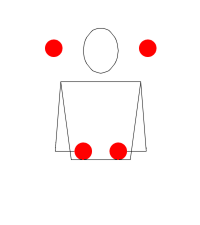No edit summary |
No edit summary |
||
| Line 14: | Line 14: | ||
===Siteswap exercises=== |
===Siteswap exercises=== |
||
| + | You can use these exercises to practice the same kind of throws that are done in this pattern, before you learn the full pattern. |
||
| − | Click on the numbers to see animations of the exercises. Both right-handed and left-handed versions of the asymmetrical patterns are shown in the animations. The full siteswap notation for each exercise is not always shown on this page. |
||
| + | |||
| + | Some of the siteswaps listed below are shortened to leave out parts where you’re not doing anything. Click on them to see animations of the exercises. |
||
| + | |||
| + | You should practice doing these starting with your right hand and with your left hand, so that you will be ready to learn the full symmetrical pattern. |
||
4 [[Ball juggling|ball]] wimpy pattern: |
4 [[Ball juggling|ball]] wimpy pattern: |
||
| Line 20: | Line 24: | ||
Prerequisites: [http://jugglinglab.sourceforge.net/siteswap.php?3 3] [[Ball juggling|ball]] [[Cascade|cascade]] |
Prerequisites: [http://jugglinglab.sourceforge.net/siteswap.php?3 3] [[Ball juggling|ball]] [[Cascade|cascade]] |
||
| − | Exercises to prepare for (4x,4x): |
+ | Exercises to prepare for [http://jugglinglab.sourceforge.net/siteswap.php?(4x,4x) (4x,4x)]: |
| − | + | *1 ball [http://jugglinglab.sourceforge.net/siteswap.php?(4x,0)(0,0)* 4x] |
|
| − | + | *2 ball [http://jugglinglab.sourceforge.net/siteswap.php?(4x,4x)(0,0) (4x,4x)] |
|
| − | + | *2 ball [http://jugglinglab.sourceforge.net/siteswap.php?(4x,0)(4x,0)* (4x,0)(4x,0)*] |
|
| − | + | *3 ball [http://jugglinglab.sourceforge.net/siteswap.php?(4x,4x)(4x,0)* (4x,4x)(4x,0)*] |
|
| − | #4 ball [http://jugglinglab.sourceforge.net/siteswap.php?(4x,4x) (4x,4x)] |
||
6 [[Ball juggling|ball]] wimpy pattern: |
6 [[Ball juggling|ball]] wimpy pattern: |
||
Prerequisites: [http://jugglinglab.sourceforge.net/siteswap.php?5 5] [[Ball juggling|ball]] [[Cascade|cascade]] |
Prerequisites: [http://jugglinglab.sourceforge.net/siteswap.php?5 5] [[Ball juggling|ball]] [[Cascade|cascade]] |
||
| − | Exercises to prepare for (6x,6x): |
+ | Exercises to prepare for [http://jugglinglab.sourceforge.net/siteswap.php?(6x,6x) (6x,6x)]: |
| − | + | *1 ball [http://jugglinglab.sourceforge.net/siteswap.php?(6x,0)(0,0)(0,0)* 6x] |
|
| − | + | *2 ball [http://jugglinglab.sourceforge.net/siteswap.php?(6x,6x)(0,0)(0,0) (6x,6x)] |
|
| − | + | *2 ball [http://jugglinglab.sourceforge.net/siteswap.php?(6x,0)(6x,0)(0,0)* (6x,0)(6x,0)*] |
|
| − | + | *3 ball [http://jugglinglab.sourceforge.net/siteswap.php?(6x,6x)(6x,0)(0,0)* (6x,6x)(6x,0)*] |
|
| − | + | *4 ball [http://jugglinglab.sourceforge.net/siteswap.php?(6x,6x)(2,2) (6x,6x)] |
|
| − | + | *3 ball [http://jugglinglab.sourceforge.net/siteswap.php?(6x,0)(6x,0)(6x,0)* (6x,0)(6x,0)(6x,0)*] |
|
| − | + | *4 ball [http://jugglinglab.sourceforge.net/siteswap.php?(6x,6x)(6x,6x)(0,0) (6x,6x)(6x,6x)] |
|
| − | + | *5 ball [http://jugglinglab.sourceforge.net/siteswap.php?(6x,6x)(6x,2)* (6x,6x)(6x,2)*] |
|
| − | + | *5 ball [http://jugglinglab.sourceforge.net/siteswap.php?(6x,6x)(6x,6x)(6x,0)* (6x,6x)(6x,6x)(6x,0)*] |
|
| − | #6 ball [http://jugglinglab.sourceforge.net/siteswap.php?(6x,6x) (6x,6x)] |
||
===Alternate names=== |
===Alternate names=== |
||
The term "wimpy pattern" is used by many jugglers, including [[Numbers juggling|numbers jugglers]] who normally use this pattern for even numbers, but some jugglers prefer to call this pattern the "synch crossing" pattern or just the "cross" pattern. |
The term "wimpy pattern" is used by many jugglers, including [[Numbers juggling|numbers jugglers]] who normally use this pattern for even numbers, but some jugglers prefer to call this pattern the "synch crossing" pattern or just the "cross" pattern. |
||
Revision as of 22:58, 3 October 2012
- "Cross" redirects here. For the other basic crossing pattern, see "Cascade".
The wimpy pattern is one of the four basic patterns in solo juggling (cascade, asynch fountain, synch fountain, and wimpy), and can be done with any even number of objects. Both hands throw at the same time, and each object is thrown at an angle, moving across from one hand to the other. All the objects are thrown to the same height.
 4 ball wimpy pattern 4 ball wimpy pattern
|
 6 ball wimpy pattern 6 ball wimpy pattern
|
 8 ball wimpy pattern 8 ball wimpy pattern
|
A wimpy pattern is written in siteswap notation as two of the same even number, inside parentheses and separated with a comma, with an "x" after each number. The basic synch crossing pattern is called the "wimpy pattern" because it's easier than the standard fountain pattern for juggling high even numbers of balls. Collisions can be avoided by throwing slightly higher with one hand, by throwing with one hand farther forward than the other, by making the throws not quite synchronous, or by just aiming to try to make the balls collide. The basic wimpy pattern is not practical for rings and clubs because of their size, but the reverse wimpy pattern with the rings turned sideways is less collision-prone. The wimpy pattern is the most common way to juggle an even number of props in bounce juggling and one-sided overhead throws. Backcrosses done in the wimpy pattern are called scissor throws.
The highest number of objects that have been qualified (at least twice as many catches as objects) in the wimpy pattern is 10 balls, and the highest number of objects that have been flashed (same number of throws and catches as objects) in the wimpy pattern is 12 balls.
[[Video:10 Ball World Record- 26 Catches by David Ferman|thumb|left|640px|David Ferman's 10 ball world record, in the wimpy pattern]]
Siteswap exercises
You can use these exercises to practice the same kind of throws that are done in this pattern, before you learn the full pattern.
Some of the siteswaps listed below are shortened to leave out parts where you’re not doing anything. Click on them to see animations of the exercises.
You should practice doing these starting with your right hand and with your left hand, so that you will be ready to learn the full symmetrical pattern.
4 ball wimpy pattern:
Exercises to prepare for (4x,4x):
- 1 ball 4x
- 2 ball (4x,4x)
- 2 ball (4x,0)(4x,0)*
- 3 ball (4x,4x)(4x,0)*
6 ball wimpy pattern:
Exercises to prepare for (6x,6x):
- 1 ball 6x
- 2 ball (6x,6x)
- 2 ball (6x,0)(6x,0)*
- 3 ball (6x,6x)(6x,0)*
- 4 ball (6x,6x)
- 3 ball (6x,0)(6x,0)(6x,0)*
- 4 ball (6x,6x)(6x,6x)
- 5 ball (6x,6x)(6x,2)*
- 5 ball (6x,6x)(6x,6x)(6x,0)*
Alternate names
The term "wimpy pattern" is used by many jugglers, including numbers jugglers who normally use this pattern for even numbers, but some jugglers prefer to call this pattern the "synch crossing" pattern or just the "cross" pattern.
